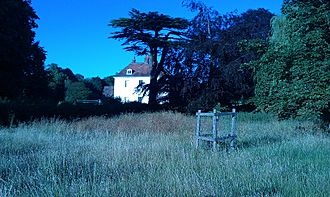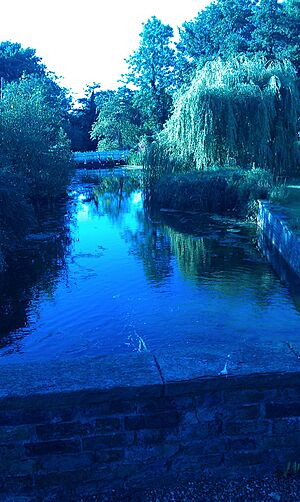St John's Jerusalem facts for kids
Quick facts for kids St John's Jerusalem |
|
|---|---|

St John's Jerusalem with Cedar of Lebanon in foreground
|
|
| Alternative names | Sutton Manor; the Manor of Sutton-at-Hone |
| General information | |
| Type | Manor House |
| Town or city | Sutton-at-Hone, Kent |
| Country | United Kingdom |
| Inaugurated | 1199 |
| Owner | National Trust |
| Designations | |
|
Listed Building – Grade II*
|
|
| Official name: St John's Jerusalem | |
| Designated: | 1 August 1952 |
| Reference #: | 1085776 |
St John's Jerusalem, also known as Sutton-at-Hone Preceptory, is a special place in Sutton-at-Hone, Kent, England. It is looked after by the National Trust. This historic site has a chapel from the 1200s that belonged to the Knights Hospitaller. It also has beautiful gardens surrounded by a moat, which is part of the River Darent. You can visit St John's Jerusalem on Wednesday afternoons from April to October.
Contents
A Look Back in Time: History of St John's Jerusalem
St John's Jerusalem started in 1199. It was a Commandry for the Knights Hospitaller. These were a group of knights who helped sick and poor pilgrims. They also protected them on their journeys. The property was sold in the 1500s during a time called the Dissolution. This is when many religious places in England were closed down.
Most of the old parts of the building were built around 1234. King Henry III even ordered five oak trees to be cut down from Tonbridge Forest for the construction. By 1388, the knights no longer used the property as a commandry.
Growing Fruit and Famous Residents
In 1670, a scientist named Abraham Hill started an orchard here. He planted apples and pears from other parts of England. These fruits were used to make cider and perry (pear cider). New types of apples, like the Kentish Pippin, were brought to Kent because of his work.
Later, from 1755, the house was home to Edward Hasted. He was a historian who wrote about the county of Kent. He spent a lot of money on the property.
Becoming a National Treasure
In 1943, a man named Sir Stephen Tallents gave the building to the nation. This meant it became a public treasure. Since 1952, St John's Jerusalem has been a Grade II* listed building. This means it is a very important historic building. It is also protected as a site of national importance. Today, the main house is a private home. However, the chapel and gardens are open for everyone to visit.
Exploring the Grounds and Moat
The moat around St John's Jerusalem is very old, dating back to the 1200s. It creates an island of about 22,200 square meters. There are three bridges over the moat. One of them is an old brick footbridge from the 1800s.
You can also see a large Cedar of Lebanon tree in the grounds. Only a small part of the moat is connected to the River Darent. The moat has sometimes had problems, like drying up in hot summers. It has also been affected by dirt building up.
The Garden's Past Uses
The garden also has an old fishpond. This pond is now a marshy area. Before the Dissolution, the lawn north of the property was used as a burial ground for the chapel. Later, it became a place where waste was thrown.


